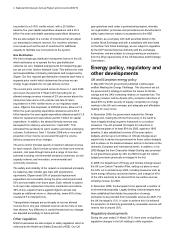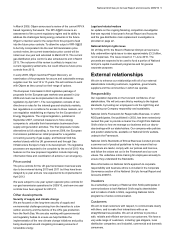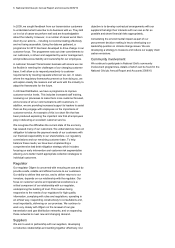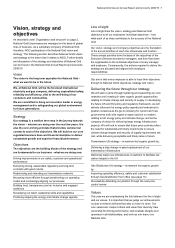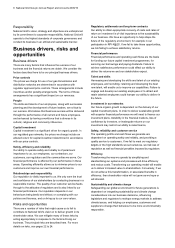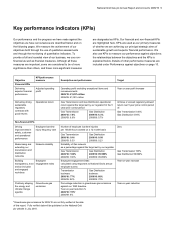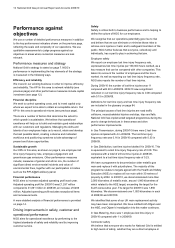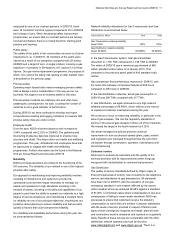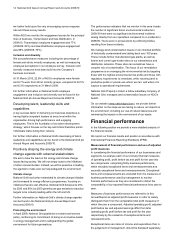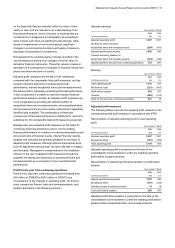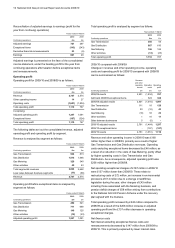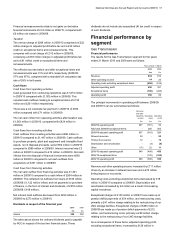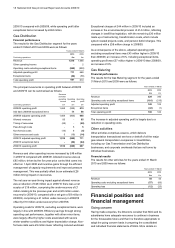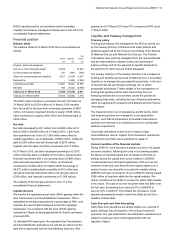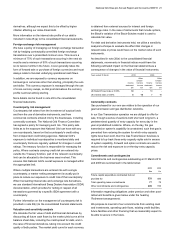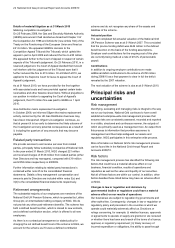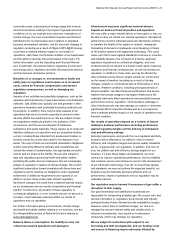National Grid 2010 Annual Report Download - page 16
Download and view the complete annual report
Please find page 16 of the 2010 National Grid annual report below. You can navigate through the pages in the report by either clicking on the pages listed below, or by using the keyword search tool below to find specific information within the annual report.
14 National Grid Gas plc Annual Report and Accounts 2009/10
we further build upon the very encouraging survey response
rate and these survey results.
Within NGG we monitor the engagement scores for the principal
lines of business, Transmission and Gas Distribution. In
2009/10, Transmission employee engagement was 77%
(2008/09: 82%) and Gas Distribution employee engagement
was 68% (2008/09: 70%).
Inclusion and diversity
We use performance measures including the percentage of
female and ethnic minority employees, as well as measuring
employee perceptions in our employee survey. Inclusion and
diversity measures have been built into the Company’s
business scorecard.
At 31 March 2010, 22.6% of NGG’s employees were female
and 6.7% were from ethnic minority groups, compared to 22.5%
and 6.3% respectively at 31 March 2009.
For further information on National Grid’s employee
engagement and Inclusion and diversity can be found in the
National Grid plc Annual Report and Accounts 2009/10.
Developing talent, leadership skills and
capabilities
A key success factor in delivering our business objectives is
having highly competent leaders at every level within the
organisation driving high performance and engaging
employees. This is the foundation of our talent development
strategy, which focuses on the key and critical transition points
individuals make during their careers.
For further information on National Grid’s developing of talent,
leadership and capabilities can be found in the National Grid plc
Annual Report and Accounts 2009/10.
Positively shaping the energy and climate
change agenda with external stakeholders
We aim to take the lead on the energy and climate change
issues facing society. We will not simply react to the initiatives
of other relevant bodies. Instead, we will be proactive in leading
the agenda to make sure we help safeguard the environment.
Climate change
National Grid has further embedded its climate change initiative
and increased its energy efficiency programmes, focusing on
initiatives that are cost effective. National Grid believes its 45%
by 2020 and 80% by 2050 greenhouse gas emissions reduction
targets to be industry leading within the UK and US.
Further information on National Grid’s climate change agenda
can be found in the National Grid plc Annual Report and
Accounts 2009/10.
Protecting the environment
In April 2009, National Grid published a revised environment
policy, reinforcing its commitment to being an innovative leader
in energy management and to safeguarding the global
environment for future generations.
The performance indicators that we monitor in this area include
the number of significant direct environmental incidents.In
2009/10 there were no significant environmental incidents
arising directly from our operations compared to no incidents In
2008/09. There were no prosecutions by enforcing bodies
resulting from these incidents.
We manage land contamination issues on an inherited portfolio
of historically contaminated land dating back over 100 years.
These include former manufactured gas plants, as well as
former and current gas holder sites on our transmission and
distribution networks. These sites can sometimes have a
complex mix of contamination. The focus of our remediation
programme is on managing the environmental risk by targeting
those with the highest environmental risk profile and those with
regulatory requirements to remediate, while returning land to
productive public or private use where we can, and where it is
surplus to operational requirements.
National Grid Property Limited, a fellow subsidiary company of
National Grid, manages land contamination issues on NGG’s
behalf.
On our website (www.nationalgrid.com), we provide further
information on the steps we are taking to reduce our impact on
the environment, including our use of natural resources and
minimising the impact on the environment of our waste.
Financial performance
In the following section we provide a more detailed analysis of
the financial results.
We report our financial results and position in accordance with
International Financial Reporting Standards (IFRS).
Measurement of financial performance and use of adjusted
profit measures
In considering the financial performance of our businesses and
segments, we analyse each of our primary financial measures
of operating profit, profit before tax and profit for the year into
two components, comprising firstly business performance,
which excludes exceptional items and remeasurements and
secondly exceptional items and remeasurements. Exceptional
items and remeasurements are excluded from the measures of
business performance used by management to monitor
financial performance as they are considered to distort the
comparability of our reported financial performance from year to
year.
Measures of business performance are referred to in this
Annual Report as adjusted profit measures in order to clearly
distinguish them from the comparable total profit measures of
which they are a component. Adjusted operating profit, adjusted
profit before tax and adjusted earnings differ from total
operating profit, profit before tax and profit for the year
respectively by the exclusion of exceptional items and
remeasurements.
Exceptional items are items of income and expenditure that, in
the judgement of management, should be disclosed separately


